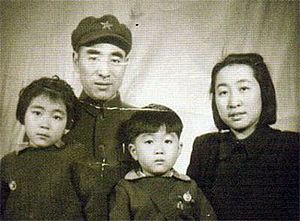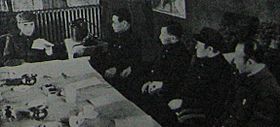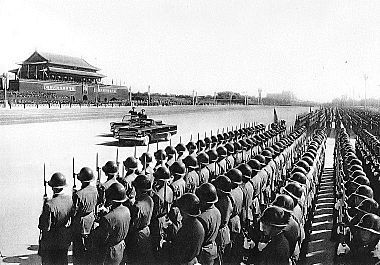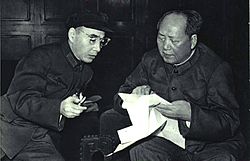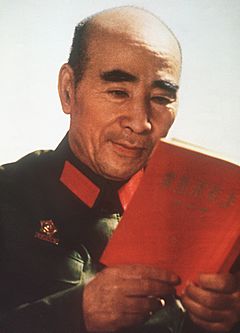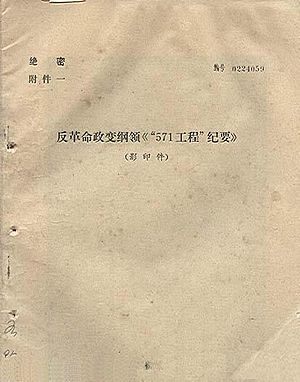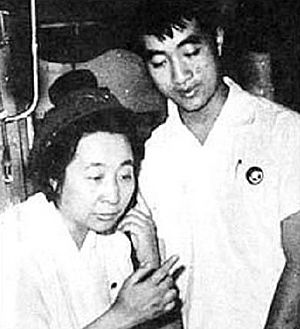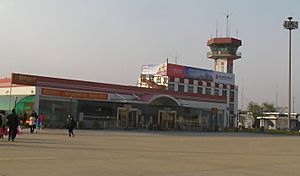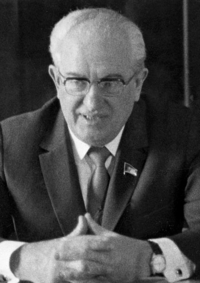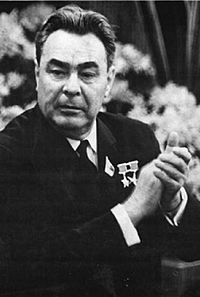Lin Biao facts for kids
Quick facts for kids
Marshal
Lin Biao
|
|
|---|---|
|
林彪
|
|
 |
|
| Vice Chairman of the Chinese Communist Party | |
| In office 25 May 1958 – 13 September 1971 |
|
| Chairman | Mao Zedong |
| First Vice Chairman of the Chinese Communist Party | |
| In office 1 August 1966 – 13 September 1971 |
|
| Chairman | Mao Zedong |
| Preceded by | Liu Shaoqi |
| Succeeded by | Zhou Enlai (1973) |
| 2nd First Vice Premier of the People's Republic of China | |
| In office 21 December 1964 – 13 September 1971 |
|
| Premier | Zhou Enlai |
| Preceded by | Chen Yun |
| Succeeded by | Deng Xiaoping |
| Vice Premier of the People's Republic of China | |
| In office 15 September 1954 – 13 September 1971 |
|
| Premier | Zhou Enlai |
| Minister of National Defense | |
| In office 17 September 1959 – 13 September 1971 |
|
| Premier | Zhou Enlai |
| Preceded by | Peng Dehuai |
| Succeeded by | Ye Jianying |
| Personal details | |
| Born | 5 December 1907 Huanggang, Hubei, Qing Empire |
| Died | 13 September 1971 (aged 63) Öndörkhaan, Mongolian People's Republic |
| Political party | Chinese Communist Party (1927–1971) |
| Spouses | Zhang Mei [zh] (1937–42) Ye Qun (1942–71) |
| Children | Lin Xiaolin [zh] (daughter) Lin Liguo (son) Lin Liheng (daughter) |
| Alma mater | Whampoa Military Academy |
| Awards | |
| Nicknames | Chief Lin (林总; Lín zǒng) |
| Military service | |
| Allegiance | |
| Branch/service | |
| Years of service | 1925–1971 |
| Rank | |
| Commands | 1st Corps 1st Red Army Corps, Chinese Red Army 115 Division, 8th Route Army People's Liberation Army |
| Lin Biao | |||||||||||||||||||||||
|---|---|---|---|---|---|---|---|---|---|---|---|---|---|---|---|---|---|---|---|---|---|---|---|

"Lin Biao" in regular Chinese characters
|
|||||||||||||||||||||||
| Chinese | 林彪 | ||||||||||||||||||||||
|
|||||||||||||||||||||||
Lin Biao (born December 5, 1907 – died September 13, 1971) was an important Chinese politician and military leader. He was a Marshal of the People's Republic of China. Lin Biao played a key role in the Chinese Communist Party's victory during the Chinese Civil War. He was especially successful in Northeast China from 1946 to 1949.
Lin Biao led major military campaigns like the Liaoshen Campaign and Pingjin Campaign. He helped lead the Manchurian Field Army to victory and brought the People's Liberation Army (PLA) into Beijing. In 1949, his forces crossed the Yangtze River, defeated the Kuomintang (Nationalist Party), and took control of China's coastal areas. He was ranked third among China's "Ten Marshals," a group of top military leaders.
After the war ended in 1949, Lin Biao did not take a very active role in politics. He served as a Vice Premier of the People's Republic of China starting in 1954. In 1958, he became a Vice Chairman of the Chinese Communist Party. From 1959, he held three important jobs: Vice Premier, Vice Chairman, and Minister of National Defense of the People's Republic of China. He was the longest-serving Minister of National Defense in China's history.
In the early 1960s, Lin Biao helped create a strong public image for Mao Zedong. Because of his support during the Cultural Revolution, Mao chose Lin Biao as his official successor in 1966. Lin Biao held this position until his death.
Lin Biao died on September 13, 1971, when the plane he was on crashed in Öndörkhaan, Mongolia. The exact reasons for this "Lin Biao incident" are still debated. The Chinese government officially stated that Lin and his family tried to escape after a failed plan to overthrow Mao. Other people believe they fled because they feared being removed from power. After his death, the Communist Party officially called Lin Biao a traitor. Since the late 1970s, Lin Biao and Mao's wife, Jiang Qing, have been blamed by the Chinese government for the worst parts of the Cultural Revolution.
Contents
Early Life and Military Career
Becoming a Revolutionary
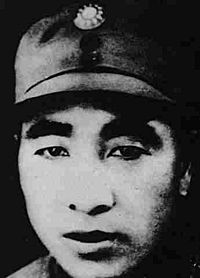
Lin Biao was born into a wealthy merchant family in Huanggang, Hubei province. His birth name was Lin Yurong. As a child, he was more interested in student protests than in school. In 1925, he joined a group connected to the Communist Youth League. Later that year, he joined the Whampoa Military Academy in Guangzhou.
At the academy, Lin Biao studied under Zhou Enlai. After graduating in 1926, Lin quickly rose through the ranks. He became a colonel by 1927. During this time, he joined the Chinese Communist Party. His first marriage, arranged by his parents, ended when he became a revolutionary.
Fighting in the Chinese Civil War
After a split between the Kuomintang and the Communists in 1927, Lin Biao joined Mao Zedong and Zhu De in a Communist base area in 1928. He became one of Mao's closest supporters. Lin became a top military commander in the Jiangxi–Fujian Soviet region. He led the First Army Group, which was known for its speed and clever attacks.
Lin believed in using guerrilla warfare tactics. This meant weakening the enemy with surprise attacks and ambushes, rather than direct battles. His ideas were similar to Mao's. In 1934, Lin was one of the first to suggest leaving the Jiangxi Soviet base. He continued to be a successful commander during the Long March. The Red Army finally reached Yan'an in 1936.
Lin Biao and Peng Dehuai were considered the Red Army's best commanders. They both supported Mao's leadership. After arriving in Yan'an, Lin became the head of the Counter-Japanese University. In 1937, he married Liu Ximin, a student there.
Second Sino-Japanese War (1937–1945)
In 1937, Lin Biao became commander of the 115th Division of the Communist 8th Route Army. He helped fight against the Japanese invasion of Shanxi. He led a successful ambush at Pingxingguan in September 1937. This was one of the few Chinese victories early in the war.
In 1938, Lin Biao was seriously injured when a sharpshooter accidentally shot him. He went to Moscow to recover and to represent the Chinese Communist Party. He stayed there until 1942. While in Moscow, his first marriage ended. He later married Ye Qun in 1943.
Leading the Manchurian Campaigns
After Japan surrendered in 1945, Lin Biao moved to Manchuria (Northeast China). He commanded the new Communist Northeast Military District. The Soviet Union gave captured Japanese military equipment to the Communists. This made Lin's army very well-equipped. By the time the Kuomintang arrived, Lin's forces controlled most of the countryside.
Lin Biao avoided big battles in 1945 to save his army's strength. In 1946, Mao ordered Lin to defend cities, which was against Lin's usual strategy. Lin's army suffered heavy losses in some battles, like at Siping. However, he learned from these experiences and reorganized his army.
By late 1947, Lin had 510,000 soldiers, about the same number as the Nationalist forces. He launched the Winter Offensive, which led to major victories. By early 1948, the Kuomintang had lost almost all of Manchuria. Lin's forces captured Siping and other key areas.
Lin then began the Liaoshen Campaign. His army surrounded Changchun and later attacked Jinzhou. After fierce fighting, Lin's forces captured Jinzhou. This led to the surrender of Nationalist forces in Changchun. By the end of 1948, all of Northeast China was under Communist control.
Defeating the Kuomintang
After securing Manchuria, Lin Biao's army moved into North China. His forces won two of the three main victories that led to the defeat of the Kuomintang. Lin's health was poor during these campaigns.
During the Pingjin Campaign, Lin's army, now over a million strong, surrounded Chiang Kai-shek's main forces in northern China. They took Beijing and Tianjin within two months. Tianjin was captured by force. Beijing surrendered peacefully on January 22, 1949. Many surrendered Nationalist soldiers later joined the PLA.
After taking Beijing, Lin's army crossed the Yangtze River in 1949. They defeated the Kuomintang army in central China. Lin's forces continued to win battles, taking control of all Kuomintang positions on mainland China by the end of 1949. Lin Biao was seen as one of the Communists' most brilliant generals. In 1955, he was named one of the "Ten Marshals" for his military achievements.
Political Life
Health Challenges
Lin Biao continued to have health problems after 1949. He often avoided important military and political jobs. He was given many high-ranking positions, but they were mostly honorary. He often said his poor health prevented him from doing his duties.
Lin's injury in 1938 caused him ongoing physical and mental health issues. He suffered from severe headaches and insomnia. He also had unusual fears, like being afraid of water, wind, cold, light, and noise. His office was kept dark and without fresh air. Some doctors believed he had manic depression. His fragile health made him easily influenced by others, especially his wife, Ye Qun.
Working with Mao Zedong
Lin Biao was slow to gain power in the early 1950s. He was named to the Politburo in 1955. In 1958, he joined the Politburo Standing Committee and became a Vice-chairman.
After Peng Dehuai criticized Mao's Great Leap Forward in 1959, Peng was removed from his positions. Lin Biao privately agreed with Peng, but he publicly supported Mao. Lin became the most public supporter of Mao after the Great Leap Forward. This was a time when Mao's economic policies caused a terrible famine.
Lin Biao became the Minister of Defense. He changed China's armed forces based on political ideas. He removed military ranks and made soldiers work part-time in factories and farms. He also taught soldiers about Mao Zedong Thought. These changes pleased Mao, who promoted Lin to higher positions.
Lin used his position to promote Mao's public image. He started propaganda campaigns, like the "learn from Lei Feng" campaign in 1963. Lin also helped put together Mao's writings into a book called the Quotations from Chairman Mao Zedong, also known as the Little Red Book. Lin's military changes and China's success in the 1962 Sino-Indian War impressed Mao. In 1966, a campaign to "learn from the People's Liberation Army" grew into the Cultural Revolution.
Cultural Revolution
Rising to Power

Lin Biao's support for Mao led to his promotion. In 1966, Mao's second-in-command, Liu Shaoqi, was criticized. Lin Biao then became the most likely person to replace Liu as Mao's successor. Lin tried to avoid this promotion, but Mao insisted.
Lin privately disagreed with the removal of Liu and Deng Xiaoping. However, he could not publicly oppose Mao. Lin became the sole Vice-chairman in 1966. He replaced Liu Shaoqi as Mao's unofficial successor. Lin tried to reject this role, but Mao refused his request.
Since he could not avoid the position, Lin tried to protect himself by fully supporting Mao. He avoided making any decisions until Mao's opinion was clear. Then, Lin would follow Mao's direction very closely. He always appeared next to Mao in public, holding a copy of the Little Red Book. He wanted everyone to believe he was Mao's closest follower.
Activities During the Cultural Revolution

Lin Biao had little interest in the Vice-chairman position. He mostly did things that would please Mao. He rarely attended government meetings unless Mao demanded it. His colleagues noticed he avoided talking about the Cultural Revolution. He became known for being quiet and mysterious. He left most of his important work and family duties to his wife, Ye Qun.
Lin's quiet approach was a way to survive the Cultural Revolution. He advised a subordinate to be "passive" to avoid trouble. Lin adopted a policy of "three 'nos': no responsibility; no suggestions; no crime."
In 1966, Lin directed Red Guards to attack those seen as opposing Mao. He called for a "three-month turmoil" within the PLA. This led to many officers being removed or harmed. Military academies were closed, and training stopped.
Lin continued to support the Red Guards until May 1967. After that, he tried to make the Cultural Revolution less extreme. He was unhappy with it privately. However, he could not avoid his high-profile role due to Mao's expectations and the actions of his wife and son. Lin tried to protect Red Guards and his allies from harm. He also tried to calm down the radical actions of Jiang Qing and her followers.

Lin and Jiang Qing worked together at first, but their relationship worsened in 1968. Jiang often tried to get involved in military matters, which Lin did not like. By 1970, Lin and Ye were very unfriendly with Jiang Qing.
From 1968 until his death, Lin and his supporters disagreed with Zhou Enlai about China's relationship with the United States and the Soviet Union. Lin thought both superpowers were equally dangerous. Zhou Enlai believed China should get closer to the United States to reduce the threat from the Soviet Union.
As Defense Minister, Lin Biao was in charge of China's response to the Zhenbao Island incident in 1969. This was a border conflict with the Soviet Union. Lin warned Chinese troops to be ready for a Soviet attack.
At the Height of Power
Lin Biao officially became China's second-in-command in April 1969. The Party constitution was changed to say he would be Mao's successor. Lin's group was very powerful within the Politburo. His supporters, many of whom were military leaders, were a strong force.
However, Mao started to feel uneasy about Lin's growing power. At a meeting in 1970, Mao began to work against Lin. Lin suggested that Mao take the position of President, but Mao refused. Mao suspected Lin was trying to increase his own power. Mao did not attack Lin directly, but he criticized Lin's ally, Chen Boda, who was quickly removed. This showed a growing mistrust between Lin and Mao.
After 1970, some groups within the Army and those led by Zhou Enlai and Jiang Qing began to distance themselves from Lin. Mao allowed Zhou to bring back some officials who had been removed during the Cultural Revolution. He also supported Zhou's efforts to improve China's relationship with the United States.
A serious disagreement grew between Mao and Lin. Mao was unhappy with Lin's comments about his wife, Jiang Qing. Mao wanted Lin to admit his mistakes, but Lin avoided Beijing. Zhou Enlai tried to help Mao and Lin resolve their issues, but Lin became very private and hard to reach. In July 1971, Mao decided to remove Lin and his supporters.
"Lin Biao Incident" and Death
Lin Biao died when a plane carrying him and his family crashed in Mongolia on September 13, 1971. The official story is that he was trying to flee after a failed attempt to harm Mao. Many people outside China have doubted this official explanation. However, an investigation by the Soviet Union, which found the bodies, confirmed that Lin was among those who died.
| Occurrence summary | |
|---|---|
| Date | 13 September 1971 |
| Summary |
|
| Place | near Öndörkhaan, Mongolia |
| Passengers | 5 |
| Crew | 4 |
| Fatalities | 9 (all) |
| Survivors | 0 |
| Aircraft type | Hawker Siddeley HS-121 Trident 1E |
| Airline/user | People's Liberation Army Air Force |
| Registration | B-256 |
| Flew from | Qinhuangdao Shanhaiguan Airport, Qinhuangdao, Hebei Province, China |
| Flying to | Soviet Union |
Official Chinese Story
According to the Chinese government, Lin Biao knew Mao no longer trusted him. He wanted to take over power. In February 1971, Lin and his wife, Ye Qun, started to plan Mao's assassination. In March 1971, Lin's son, Lin Liguo, who was an Air Force officer, met secretly with his followers. They supposedly wrote a plan for a takeover called "Project 571." In Chinese, "5-7-1" sounds like "armed uprising."
Mao was unaware of this plan. In August 1971, Mao planned a meeting to decide Lin Biao's future. On September 5, Lin heard that Mao was preparing to remove him from power. On September 8, Lin ordered his followers to go ahead with the plan.
Lin's followers planned to assassinate Mao by sabotaging his train. But Mao unexpectedly changed his route on September 11. Mao's bodyguards stopped other attempts on his life, and Mao returned safely to Beijing. Lin's plan failed.
Realizing his plan had failed, Lin's group first thought about fleeing to their power base in Guangzhou. But they decided it was not practical. Instead, they chose to flee to the Soviet Union. In the early morning of September 13, Lin Biao, Ye Qun, Lin Liguo, and some aides boarded a plane. The plane did not have enough fuel. It crashed near Öndörkhaan in Mongolia. All nine people on board died.
Other Views of the Incident
The exact details of Lin's death are still unclear. Many government records about his death were destroyed. This makes it hard to know exactly what happened. The Chinese government has used confessions from officials close to Lin to support its story. However, scholars outside China often do not trust these confessions.
Since 1971, many scholars outside China have doubted the official story. They question why Lin, one of Mao's closest supporters, would attempt a poorly planned takeover. They also question why his plane crashed. Some believe Lin's decision to flee to the Soviet Union was not logical.
Some historians have suggested that Lin did not intend to take Mao's place. One idea is that he opposed China becoming friends with the United States. This was something Zhou Enlai was arranging with Mao's approval. Because the Chinese government never showed proof that Lin was on the plane, some scholars first doubted he died in the crash. Some even suggested Mao ordered the plane to be shot down.
The Chinese government has not wanted to change its story about Lin Biao's death. They say they have a "clear, authoritative conclusion." Scholars believe China wants to avoid criticizing Mao Zedong or rethinking the Cultural Revolution.
Eyewitness Accounts
A study in 1994 looked at evidence from different countries. It confirmed that Lin Biao, Ye Qun, and Lin Liguo all died in the crash. However, the study found that Lin's plane was flying away from the Soviet Union when it crashed. This makes the events more confusing. It also makes it less likely that Lin was trying to get help from the Soviet Union. Lin's wife and son might have forced him onto the plane.
According to Zhang Ning, Lin Liguo's fiancée, Lin Biao was very passive by 1971. When Lin Liguo told Ye Qun that Mao was going to remove Ye from power, they decided to escape.
The night before they fled, Ye Qun announced the family would fly to Guangzhou. Lin's daughter, Lin Liheng (Doudou), opposed the plan. She called Zhou Enlai to warn him. Zhou received the message and ordered that the plane could not take off without his written permission. He also ordered two planes to be ready in Beijing so he could fly to Lin's residence.
Ye Qun and Lin Liguo woke Lin Biao and put him in a car. They drove to the airport. Lin Biao was so weak he had to be pulled onto the plane with a rope ladder.
After taking off, Lin's plane first flew southeast, towards Guangzhou. Then it turned back and circled the airport. The runway lights were off. Soviet and Mongolian witnesses said the plane then flew north, towards the Soviet border. But it turned around again and flew south before crashing. A Mongolian witness said the plane's tail was on fire. The crash happened around 3:00 AM.
Zhou Enlai learned that Lin's plane had taken off. He asked Mao if he wanted to order the plane shot down, but Mao said to "let him go." Later, the Mongolian Foreign Ministry told the Chinese ambassador that the plane had crashed, killing everyone.
Mongolian investigators were the first to inspect the crash site. They found Lin Liguo's identity card. They confirmed the plane and passengers were from China. Later, a Soviet medical team secretly examined the bodies. In 1972, they concluded the bodies were Lin Biao and Ye Qun. The Soviet report was kept secret until the early 1990s.
Aftermath of the Incident
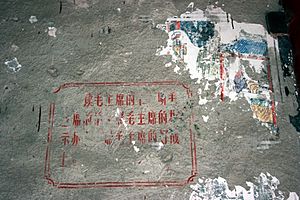
Lin Biao was survived by two daughters. Many military officials close to Lin were removed from their positions within weeks. Over 1,000 senior military officials were purged within a month. This event showed that the idea of Mao always being right was not true within the Party. The National Day celebrations on October 1, 1971, were canceled.
The news of Lin's death was announced to Party officials in mid-October 1971 and to the public in November. People were shocked and confused. Mao Zedong was deeply affected by the incident. His health worsened, and he became depressed. Mao began to support Zhou Enlai's efforts to bring back veteran revolutionaries and correct some of the Cultural Revolution's problems.
After Lin's supporters were removed, Zhou Enlai became the second most powerful person in China. Jiang Qing and her followers could not remove him. The part of the Party constitution that named Lin as Mao's successor was not officially changed until August 1973.
The Chinese government's view of Lin Biao changed over time. For a year, the Party tried to hide the details of his death. Then, they released some information and started a propaganda campaign against Lin Biao. After Mao's death in 1976, the government confirmed its condemnation of Lin.
In 1973, Jiang Qing started a campaign to criticize Lin Biao. This campaign used Lin's bad image to attack Zhou Enlai. This involved making up false stories about Lin opposing Mao throughout his career. After Lin's death, some of his private notes were found. These notes showed his critical opinions of Mao. For example, Lin wrote that Mao "worships himself" and "all accomplishments are attributed to him, but all mistakes are made by others." These private thoughts were very different from what Lin said in public.
After Mao's death in 1976, many negative parts of the Cultural Revolution were blamed on Lin. In 1980, the Chinese government held "special trials" to find those most responsible for the Cultural Revolution. In 1981, they said Lin Biao and Jiang Qing were the two main "counter-revolutionary groups." They were blamed for using Mao's "mistakes" to gain power and for "criminal activity." Lin was blamed for removing China's head of state, Liu Shaoqi, using "false evidence." Since then, Lin has been officially remembered as one of modern China's biggest villains.
For many years, Lin's name and image were censored in China. But recently, a more balanced view of Lin has appeared. His former aides and family members have published their memories. Scholars have studied evidence about his life and death. Lin's name has reappeared in Chinese history textbooks, recognizing his contributions to the Red Army's victory. In modern China, Lin is seen as one of the Red Army's best military strategists. In 2007, a large portrait of Lin was added to the Military Museum of the Chinese People's Revolution in Beijing. It is part of a display honoring the "Ten Marshals," who founded China's armed forces.
Images for kids
See also
 In Spanish: Lin Biao para niños
In Spanish: Lin Biao para niños
- People's Liberation Army
- List of officers of the People's Liberation Army
- 9th Politburo of the Chinese Communist Party
- Ye Qun
- Huang Yongsheng
- Li Zuopeng
- Wu Faxian
- Qiu Huizuo
- Chen Boda


